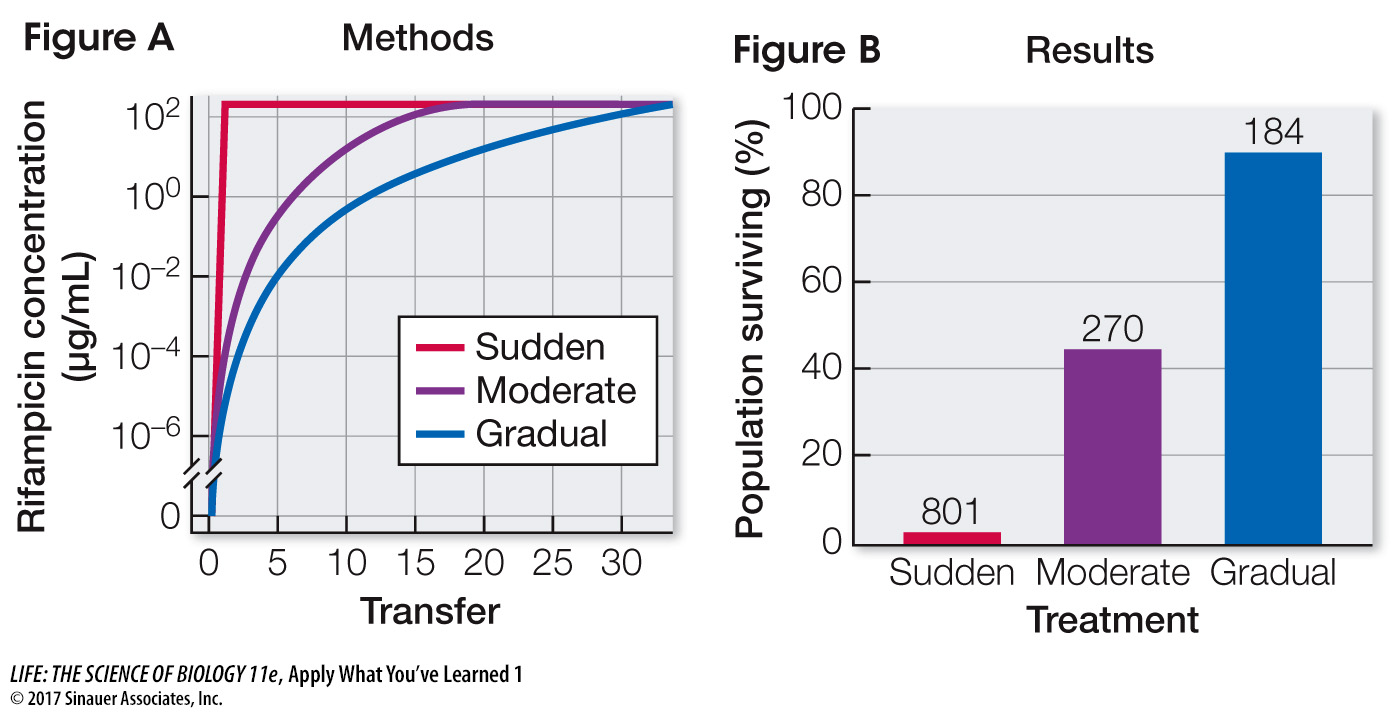Apply What You’ve Learned
Review
1.1
Living organisms have influenced the history of the planet Earth.
1.1
Major characteristics are shared among all living things.
1.1
Biological populations change over time.
1.2
Scientific methods produce biological knowledge.
1.3
Biology contributes many things to society.
Original Paper: Lindsey, H. A., J. Gallie, S. Taylor, and B. Kerr. 2013. Evolutionary rescue from extinction is contingent on a lower rate of environmental change. Nature 494: 463–
As many as half of the antibiotics that are used in human medicine may be incorrectly prescribed or completely unnecessary. Antibiotics are also given to food animals in an effort to prevent disease. A general overuse of these drugs has contributed to a significant increase in drug-
Researchers used serial transfer to propagate 1,255 populations of the bacterium Escherichia coli in an environment in which concentrations of the antibiotic rifampicin were increased over time. Each population began in liquid medium containing no antibiotic and ended at the same maximum concentration of rifampicin.

During the serial transfers, populations received one of three treatments. Populations designated as “Sudden” were exposed to the maximum rifampicin concentration immediately after their first transfer and continued to receive this maximum concentration in each subsequent transfer. Populations designated as “Moderate” were exposed to moderately increasing concentrations of rifampicin; the maximum concentration of rifampicin was reached halfway through the transfers. Populations designated as “Gradual” were exposed to more gradual increases of rifampicin; the maximum concentration of rifampicin was reached at the very end of the transfers.
Figure A summarizes the treatment conditions and Figure B shows the percentage of populations in each treatment that survived the experiment. The number above each bar shows how many of the initial 1,255 populations underwent each type of treatment.
Questions
1.
What do the results of this investigation show about the effects of sudden versus gradual environmental changes on the evolution of biological populations? Explain how these results help explain extinctions and adaptations of populations in changing environments.
The results show that a population is more likely to go extinct if a deleterious environmental change is sudden and less likely to go extinct if the change is gradual. The complete loss of a species is more likely to happen if a deleterious change in the environment occurs rapidly and wipes out most of the populations of that species. Even if a few individuals survive, they may not be present in large enough numbers to effectively reproduce and maintain a viable population. However, if the environmental change is gradual, the population has time to allow surviving members to reproduce and enhance the proportion of individuals with the ability to survive, which allows the population to undergo adaptation to the change.
2.
In what ways does this investigation model events that shaped the history of life on Earth?
The investigation shows how populations of living things evolve in response to changing environments. It models the process of natural selection that operates on populations and results in evolution. Environmental change and natural selection have helped shape the characteristics of organisms throughout the history of life on Earth.
3.
Explain what makes it reasonable for us to infer that similar results would be observed if this investigation were repeated using a plant, insect, or mammal population in a changing environment.
All living things on Earth arose from a common ancestor and share certain characteristics. For example, all living things contain DNA, which encodes the information that passes from generation to generation. DNA is affected by mutation, which produces variation within a population. All living things are also affected by natural selection, which results in adaptation of populations and species over time. Because all living things possess DNA and are affected by natural selection, the results of the investigation are expected to be broadly applicable to life.
4.
Identify this investigation as either a comparative or a controlled study. Design an experiment of the other type of study that tests the hypothesis that organisms can develop adaptations to changing surroundings. Explain your reasoning.
This was a controlled study because all of the cells were treated the same way (all variables were controlled) except for one condition that was varied. The varied condition was the amount of rifampicin added to the culture medium. (EXAMPLE) A comparative study could track changes in characteristics of a population of fish (or other species) cut in two by the building of a dam or other human-
5.
Suppose a research organization has requested funding for long-
Yes. The research organization could use the results of the investigation as an example to show that any population of bacteria likely has some proportion of individuals with genetic mutations that allow a degree of resistance to an antibiotic. Over time, selection for resistance will result in an increasing proportion of individual bacteria in that population that can grow in the presence of the antibiotic. Therefore, an antibiotic effective at killing bacteria does not remain effective over time as the bacterial populations evolve resistance to the antibiotic. This means that new antibiotics need to be developed periodically to take the place of older ones that lose their effectiveness as bacteria develop resistance to them. Using this reasoning, the research organization can show the need for a continuous pipeline of new antibiotics to deal with the problem of bacterial resistance.